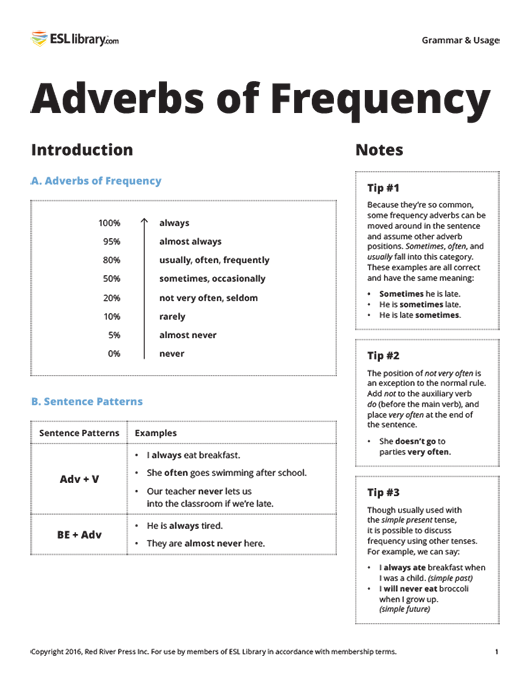Share this post
Updated June 2016
How often do you study adverbs of frequency?
Students study adverbs of frequency (aka adverbs of time, frequency adverbs) early on because they are used with the simple present tense. These handy adverbs are used to convey how often an action is done. But because we have so many ways to indicate frequency in English, it can be difficult for learners to remember the meaning difference for these adverbs.
I’ve found that using percentages when teaching adverbs of frequency really helps students comprehend the differences in meaning. Share our chart in class, and then try the fun activity suggested at the end of this post!
Sentence Patterns
1. Adv + V
2. BE + Adv
These adverbs come before the main verb (unlike Adverbs of Manner, which come after the verb) and are usually used with the simple present tense. Remind students of the Be verb exception, where these adverbs come after, not before, the Be verb.
Examples
- I always eat breakfast. (Adv + V)
- She often goes swimming after school. (Adv + V)
- Our teacher never lets us into the class if we’re late. (Adv + V)
- He is always tired. (BE + Adv)
- They are almost never here. (BE + Adv)
Notes
- Because they’re so common, some frequency adverbs can be moved around in the sentence and assume other adverb positions. Sometimes, often, and usually fall into this category. We can say, with the same meaning in each case, Sometimes he is late, He is sometimes late, and He is late sometimes.
- The position of not very often is an exception to the normal rule. We add not to the auxiliary verb do (before the verb), and very often goes at the end of the sentence (e.g., She doesn’t go to parties very often).
- Though usually used with the simple present tense, it is possible to discuss frequency using other tenses. For example, we can say I always ate breakfast when I was a child (simple past) and I will never eat broccoli when I grow up (simple future).
Activity
I often do this simple, student‑produced activity after introducing adverbs of frequency. Encourage students to try using all the adverbs in the scale above (make sure they’re not just repeating “sometimes” over and over).
Step #1
Distribute five slips of paper to each student and have them write an action on each slip. Give some examples such as “eat pizza,” “sing in the shower,” “call a friend,” etc. They can also write silly ones like “see a UFO” or “star in a movie”!
Step #2
Collect the slips of paper and mix them up. Divide students into group of four or five. Divide up the slips and hand them out to the groups.
Step #3
Have students take turns picking up a card and forming a question using “how often.” Each group member should answer using an adverb of frequency.
Practice
- Adverbs of Frequency
- Adverbs of Manner
- Adverbs of Time
- Simple Present: How often do you?
- Daily Routines
- Daily Routines Flashcards
For more tips on adverbs, see 7 Adverb Patterns on our blog.
Comments (3)
Anonymous A.(Teacher)
March 4, 2015 at 10:22 am

Tanya Trusler(Author)
March 4, 2015 at 11:04 pm
Ari Guerrero(Guest)
September 6, 2017 at 8:19 am

Tanya Trusler(Author)
September 12, 2017 at 4:54 am
Hablemos F.(Teacher)
August 21, 2021 at 7:26 pm
Lei Kayanuma(Ellii Staff)
August 23, 2021 at 2:53 pm

